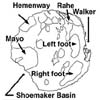| . |  |
. |
Columbus OH (SPX) Jun 17, 2005 Science fiction writer Harlan Ellison once said that the most common elements in the universe are hydrogen and stupidity. While the verdict is still out on the volume of stupidity, scientists have long known that hydrogen is indeed by far the most abundant element in the universe. When they peer through their telescopes, they see hydrogen in the vast clouds of dust and gas between stars -- especially in the denser regions that are collapsing to form new stars and planets. But one mystery has remained: why is much of that hydrogen in molecular form -- with two hydrogen atoms bonded together -- rather than its single atomic form? Where did all that molecular hydrogen come from? Ohio State University researchers recently decided to try to figure it out. They discovered that one seemingly tiny detail -- whether the surfaces of interstellar dust grains are smooth or bumpy -- could explain why there is so much molecular hydrogen in the universe. They reported their results at the 60th International Symposium on Molecular Spectroscopy, held at Ohio State University. Hydrogen is the simplest atomic element known; it consists of just one proton and one electron. Scientists have always taken for granted the existence of molecular hydrogen when forming theories about where all the larger and more elaborate molecules in the universe came from. But nobody could explain how so many hydrogen atoms were able to form molecules - until now. For two hydrogen atoms to have enough energy to bond in the cold reaches of space, they first have to meet on a surface, explained Eric Herbst, Distinguished University Professor at Ohio State. Though scientists suspected that space dust provided the necessary surface for such chemical reactions, laboratory simulations of the process never worked. At least, they didn't work well enough to explain the full abundance of molecular hydrogen that scientists see in space. Herbst, professor of physics, chemistry, and astronomy, joined with Herma Cuppen, a postdoctoral researcher, and Qiang Chang, a doctoral student, both in physics, to simulate different dust surfaces on a computer. They then modeled the motion of two hydrogen atoms tumbling along the different surfaces until they found one another to form a molecule. Given the amount of dust that scientists think is floating in space, the Ohio State researchers were able to simulate the creation of the right amount of hydrogen, but only on bumpy surfaces. When it comes to making molecular hydrogen, the ideal microscopic host surface is "less like the flatness of Ohio and more like a Manhattan skyline," Herbst said. The problem with past simulations, it seems, is that they always assumed a flat surface. Cuppen understands why. "When you want to test something, starting with a flat surface is just faster and easier," she said She should know. She's an expert in surface science, yet it still took her months to assemble the bumpy dust model, and she's still working to refine it. Eventually, other scientists will be able to use the model to simulate other chemical reactions in space. In the meantime, the Ohio State scientists are collaborating with colleagues at other institutions who are producing and using actual bumpy surfaces that mimic the texture of space dust. Though real space dust particles are as small as grains of sand, these larger, dime-sized surfaces will enable scientists to test whether different textures help molecular hydrogen to form in the lab. Related Links Ohio State scientists SpaceDaily Search SpaceDaily Subscribe To SpaceDaily Express  Seattle, WA (SPX) Jun 21, 2004
Seattle, WA (SPX) Jun 21, 2004Findings from a historic encounter between NASA's Stardust spacecraft and a comet have revealed a much stranger world than previously believed. The comet's rigid surface, dotted with towering pinnacles, plunging craters, steep cliffs, and dozens of jets spewing violently, has surprised scientists.
|
| ||||||||||
| The content herein, unless otherwise known to be public domain, are Copyright 1995-2016 - Space Media Network. All websites are published in Australia and are solely subject to Australian law and governed by Fair Use principals for news reporting and research purposes. AFP, UPI and IANS news wire stories are copyright Agence France-Presse, United Press International and Indo-Asia News Service. ESA news reports are copyright European Space Agency. All NASA sourced material is public domain. Additional copyrights may apply in whole or part to other bona fide parties. Advertising does not imply endorsement, agreement or approval of any opinions, statements or information provided by Space Media Network on any Web page published or hosted by Space Media Network. Privacy Statement All images and articles appearing on Space Media Network have been edited or digitally altered in some way. Any requests to remove copyright material will be acted upon in a timely and appropriate manner. Any attempt to extort money from Space Media Network will be ignored and reported to Australian Law Enforcement Agencies as a potential case of financial fraud involving the use of a telephonic carriage device or postal service. |